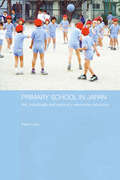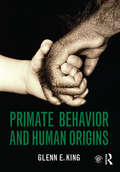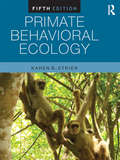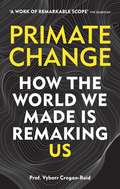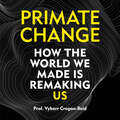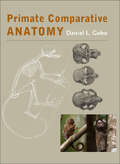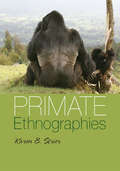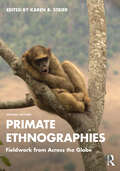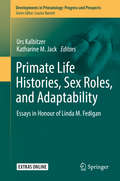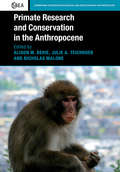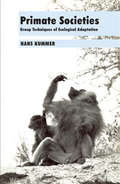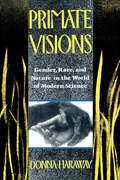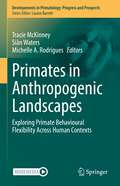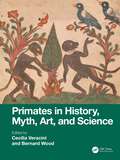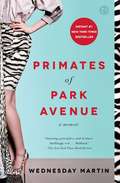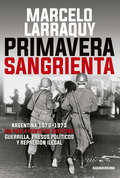- Table View
- List View
Primary School in Japan: Self, Individuality and Learning in Elementary Education (Japan Anthropology Workshop Series)
by Peter CaveThe balance between individual independence and social interdependence is a perennial debate in Japan. A series of educational reforms since 1990, including the implementation of a new curriculum in 2002, has been a source of fierce controversy. This book, based on an extended, detailed study of two primary schools in the Kinki district of Japan, discusses these debates, shows how reforms have been implemented at the school level, and explores how the balance between individuality and social interdependence is managed in practice. It discusses these complex issues in relation to personal identity within the class and within the school, in relation to gender issues, and in relation to the teaching of specific subjects, including language, literature and mathematics. The book concludes that, although recent reforms have tended to stress individuality and independence, teachers in primary schools continue to balance the encouragement of individuality and self-direction with the development of interdependence and empathy.
Primate Behavior and Human Origins
by Glenn E. KingThis comprehensive introduction demonstrates the theoretical perspectives and concepts that are applied to primate behavior, and explores the relevance of non-human primates to understanding human behavior. Using a streamlined and student-friendly taxonomic framework, King provides a thorough overview of the primate order. The chapters cover common features and diversity, and touch on ecology, sociality, life history, and cognition. Text boxes are included throughout the discussion featuring additional topics and more sophisticated taxonomy. The book contains a wealth of illustrations, and further resources to support teaching and learning are available via a companion website. Written in an engaging and approachable style, this is an invaluable resource for students of primate behavior as well as human evolution.
Primate Behavioral Ecology
by Karen B. StrierThis comprehensive introductory text integrates evolutionary, ecological, and demographic perspectives with new results from field studies and contemporary noninvasive molecular and hormonal techniques to understand how different primates behave and the significance of these insights for primate conservation. Each chapter is organized around the major research themes in the field, with Strier emphasizing the interplay between theory, observations, and conservation issues. Examples are drawn from the "classic" primate field studies as well as more recent studies on previously neglected species, illustrating the vast behavioral variation that exists across the primate order. Primate Behavioral Ecology 5th Edition also examines how anthropogenic activities are negatively impacting primate populations, including a thorough analysis of behavioural plasticity and its implications. This fully updated new edition incorporates exciting new discoveries and the most up-to-date approaches in the field to provide an invaluable overview of the field of primate behavioral ecology and its applications to primate conservation. It is considered to be a "must read" for all students interested in primates.
Primate Behavioral Ecology
by Karen B. StrierThis comprehensive introductory text integrates evolutionary, ecological, and demographic perspectives with new results from field studies and contemporary noninvasive molecular and hormonal techniques to understand how different primates behave and the significance of these insights for primate conservation. Each chapter is organized around the major research themes in the field, with Strier emphasizing the interplay between theory, observations, and conservation issues. Examples are drawn from the "classic" primate field studies as well as more recent studies, including many previously neglected species, to illustrate the vast behavioral variation that exists across the primate order. Primate Behavioral Ecology 6th Edition integrates the impacts of anthropogenic activities on primate populations, including zoonotic disease and climate change, and considers the importance of behavioral flexibility for primate conservation. This fully updated new edition brings exciting new methods, theoretical perspectives, and discoveries together to provide an incomparable overview of the field of primate behavioral ecology and its applications to primate conservation. It is considered to be a "must read" for all students interested in primates.
Primate Change: How the world we made is remaking us
by Vybarr Cregan-Reid'A work of remarkable scope' - GuardianFT Best science books of 2018Primate Change has been adapted into a radio series for the BBC WORLD SERVICE.*This is the road from climate change to primate change.PRIMATE CHANGE is a wide-ranging, polemical look at how and why the human body has changed since humankind first got up on two feet. Spanning the entirety of human history - from primate to transhuman - Vybarr Cregan-Reid's book investigates where we came from, who we are today and how modern technology will change us beyond recognition.In the last two hundred years, humans have made such a tremendous impact on the world that our geological epoch is about to be declared the 'Anthropocene', or the Age of Man. But while we have been busy changing the shape of the world we inhabit, the ways of living that we have been building have, as if under the cover of darkness, been transforming our bodies and altering the expression of our DNA, too.Primate Change beautifully unscrambles the complex architecture of our modern human bodies, built over millions of years and only starting to give up on us now.'Our bodies are in a shock. Modern living is as bracing to the human body as jumping through a hole in the ice. Our bodies do not know what century they were born into and they are defending and deforming themselves in response.'
Primate Change: How the world we made is remaking us
by Vybarr Cregan-ReidIF YOU THINK YOU ARE YOU, THINK AGAIN.PRIMATE CHANGE is a wide-ranging, polemical look at how and why the human body has changed since humankind first got up on two feet. Spanning the entirety of human history - from primate to transhuman - Vybarr Cregan-Reid's book investigates where we came from, who we are today and how modern technology will change us beyond recognition.In the last two hundred years, humans have made such a tremendous impact on the world that our geological epoch is about to be declared the 'Anthropocene', or the Age of Man. But while we have been busy changing the shape of the world we inhabit, the ways of living that we have been building have, as if under the cover of darkness, been transforming our bodies and altering the expression of our DNA, too.PRIMATE CHANGE beautifully unscrambles the complex architecture of our modern human bodies, built over millions of years and only starting to give up on us now.'Our bodies are in a shock. Modern living is as bracing to the human body as jumping through a hole in the ice. Our bodies do not know what century they were born into and they are defending and deforming themselves in response'
Primate Change: How the world we made is remaking us
by Vybarr Cregan-ReidIF YOU THINK YOU ARE YOU, THINK AGAIN.PRIMATE CHANGE is a wide-ranging, polemical look at how and why the human body has changed since humankind first got up on two feet. Spanning the entirety of human history - from primate to transhuman - Vybarr Cregan-Reid's book investigates where we came from, who we are today and how modern technology will change us beyond recognition.In the last two hundred years, humans have made such a tremendous impact on the world that our geological epoch is about to be declared the 'Anthropocene', or the Age of Man. But while we have been busy changing the shape of the world we inhabit, the ways of living that we have been building have, as if under the cover of darkness, been transforming our bodies and altering the expression of our DNA, too.PRIMATE CHANGE beautifully unscrambles the complex architecture of our modern human bodies, built over millions of years and only starting to give up on us now.'Our bodies are in a shock. Modern living is as bracing to the human body as jumping through a hole in the ice. Our bodies do not know what century they were born into and they are defending and deforming themselves in response'(p) 2018 Octopus Publishing Group
Primate Comparative Anatomy
by Daniel L. GeboA comprehensive, illustrated textbook that reveals the structural and functional anatomy of primates.Winner of the CHOICE Outstanding Academic Title of the Choice ACRLWhy do orangutan arms closely resemble human arms? What is the advantage to primates of having long limbs? Why do primates have forward-facing eyes? Answers to questions such as these are usually revealed by comparative studies of primate anatomy.In this heavily illustrated, up-to-date textbook, primate anatomist Daniel L. Gebo provides straightforward explanations of primate anatomy that move logically through the body plan and across species. Including only what is essential in relation to soft tissues, the book relies primarily on bony structures to explain the functions and diversity of anatomy among living primates. Ideal for college and graduate courses, Gebo's book will also appeal to researchers in the fields of mammalogy, primatology, anthropology, and paleontology.Included in this book are discussions of:• Phylogeny• Adaptation• Body size• The wet- and dry-nosed primates• Bone biology• Musculoskeletal mechanics• Strepsirhine and haplorhine heads• Primate teeth and diets• Necks, backs, and tails• The pelvis and reproduction• Locomotion• Forelimbs and hindlimbs• Hands and feet• Grasping toes
Primate Ethnographies
by Karen B. StrierApplies an ethnographic perspective to the study of primatesPrimate Ethnographies, 1/e is a collection of first-person accounts of immersive field studies of primates, people, and institutions, revealing the wide spectrum of primate science (primatology). Essays cover such primates as lemurs, New World monkeys, Old World monkeys, and apes. Readers experience the excitement of discovery and the challenges of primate field research. Primate Ethnographies can be used as a textbook or a companion reader.
Primate Ethnographies: Fieldwork from Across the Globe
by Karen B. StrierThis new, second edition of Primate Ethnographies: Fieldwork from Across the Globe is a collection of first-person accounts of immersive field studies of primates, people, and institutions, revealing the excitement of studying wild primates and the multi-faceted challenges involved in conducting field research.This collection of essays spans the diversity of the Primate Order, from lemurs, to monkeys and apes. The ethnographic accounts are written by experts whose diverse backgrounds and experiences reveal the broader nature of the primatological field experience and provide glimpses into the many different pathways one can follow into the field of contemporary primatology. This new edition features updated chapters from original contributors, as well as new voices from across the global north and south representing cutting edge scholarship in the field. Collectively, these essays provide insights into the driving concerns of field primatology as it is practiced across the world.Primate Ethnographies: Fieldwork from Across the Globe is of interest to students from fields across the academy including Primatology, Anthropology, Wildlife Ecology, Zoology, Conservation Biology, and Science/Nature Writing.
Primate Life Histories, Sex Roles, and Adaptability: Essays in Honour of Linda M. Fedigan (Developments in Primatology: Progress and Prospects)
by Urs Kalbitzer Katharine M. JackProfessor Linda M. Fedigan, Member of the Order of Canada and a Fellow of the Royal Society of Canada, has made major contributions to our understanding of the behavioural ecology of primates. Furthermore, Linda Fedigan pioneered and continues to advance scholarship on the role of women in science, as well as actively promoting the inclusion of women in the academy. A symposium in honour of her career was held in Banff (Alberta, Canada) in December 2016, during which former and current students and collaborators, as well as scientists with similar research interests, presented and discussed their work and their connections to Linda Fedigan. These presentations and discussions are here presented as chapters in this festschrift. The original works presented in this book are organized around four major research areas that have been greatly advanced and influenced by Linda Fedigan:Primate life historiesSex roles, gender, and sciencePrimate-environment interactionsPrimate adaptation to changing environments
Primate Locomotion
by Kristiaan D'Août Evie E. VereeckePrimate locomotion has typically been studied from two points of view. Laboratory-based researchers have focused on aspects like biomechanics and energetics, whereas field-based researchers have focused on (locomotor) behaviour and ecology. Unfortunately, to date, there is relatively little scientific exchange between both groups. With a book, which will be the result of a symposium on the 2008 Meeting of the International Primatological Society in Edinburgh, we would like to bring together laboratory and field-based primate locomotion studies. We are convinced this will be beneficial for both research lines. For example, biomechanists might wonder how frequently the locomotor style they study in the lab actually occurs in nature, and field workers might use calculated costs of locomotion to understand why certain locomotor behaviours are favoured under specific conditions. Thus, on the one hand, an established link between both groups may help interpret the results by using each other's findings. On the other hand, recent technological advances (e.g. portable high-speed cameras) make it possible to bridge the gap between lab-based and field-based research by actually collecting biomechanical data in situ. Again, communication between both groups is necessary to identify the specific needs and start up achievable and successful research projects in the field. In order to generate a wide interest, we have invited biomechanists, ecologists, and field-based researchers who combine both disciplines, and we hope their combined contributions will facilitate lasting cooperation between the mentioned disciplines and stimulate innovative research in Primatology. We are convinced that the most appropriate format to publish the different symposium contributions is a conference volume within an existing book series. Firstly, the chapters will not only contain new data but will also review existing data and elaborate on potential future work - more so than can be done in a journal article. Secondly, the combination of chapters will form an entity that is more valuable than the sum of the separate chapters and therefore they need to be presented together. Lastly, this volume will benefit from the typically long "shelf life" of a book in a renowned series, allowing it to be used as reference book for both researchers and students.
Primate Research and Conservation in the Anthropocene (Cambridge Studies in Biological and Evolutionary Anthropology #82)
by Alison M. Behie Julie A. Teichroeb Nicholas MaloneThis book takes a new approach to understanding primate conservation research, adding a personal perspective to allow readers to learn what motivates those doing conservation work. When entering the field over a decade ago, many young primatologists were driven by evolutionary questions centered in behavioural ecology. However, given the current environment of cascading extinctions and increasing threats to primates we now need to ensure that primates remain in viable populations in the wild before we can simply engage in research in the context of pure behavioural ecology. This has changed the primary research aims of many primatologists and shifted our focus to conservation priorities, such as understanding the impacts of human activity, habitat conversion or climate change on primates. This book presents personal narratives alongside empirical research results and discussions of strategies used to stem the tide of extinction. It is a must-have for anyone interested in conservation research.
Primate Societies: Group Techniques of Ecological Adaptation (Worlds Of Man Ser.)
by Hans KummerIn this book, Hans Kummer, one of the world's leading primate ethologists, examines the patterns of social interaction among primates. He examines this social behavior from the fundamentally biological viewpoint of evolutionary adaptation as part of the survival mechanisms for the species. Recognizing that all activity is constituted in part of genetic programming and in part of adaptive behavior, he explores the borderline area between the genetic and the "cultural." By use of astute observation and clever experimentation he shows that many aspects of social behavior are inherited, and differentially inherited among various primate groups. These data also show, however, that the individuals and troops learn much in primate social life and that these forms are responsive to particular ecological situations. Drawing heavily on knowledge gleaned from his own well-known studies of the Hamadryas baboon, Dr. Kummer introduces the reader to the daily life of a particular primate society. From this sample case, he proceeds to a more general characterization of primate societies, using as examples the great apes and monkeys of Africa, Asia, and South America and particularly the widely studied terrestrial monkey species. The particularities of primate communication, social structure, and economy are described and special attention is devoted to the primate counterparts of kinship and age groups-behavioral differences based on age and sex, and mating and grouping systems. This is followed by a chapter dealing with the ecological functions of the major parameters of primate social life, such as group size and the coordination of activities within it-dominance, leadership systems, and spatial arrangements. The second part of the book is concerned with the origins of behavioral traits of primates, discussed from phylogenetic, ecological, and cultural points of view, again using data-based examples. Dr. Kummer explains why some traits have not evolved that would have been ada
Primate Visions: Gender, Race, and Nature in the World of Modern Science
by Donna HarawayHaraway's discussions of how scientists have perceived the sexual nature of female primates opens a new chapter in feminist theory, raising unsettling questions about models of the family and of heterosexuality in primate research.
Primate Visions: Gender, Race, and Nature in the World of Modern Science
by Donna J. HarawayHaraway's discussions of how scientists have perceived the sexual nature of female primates opens a new chapter in feminist theory, raising unsettling questions about models of the family and of heterosexuality in primate research.
Primates in Anthropogenic Landscapes: Exploring Primate Behavioural Flexibility Across Human Contexts (Developments in Primatology: Progress and Prospects)
by Tracie McKinney Siân Waters Michelle A. RodriguesThe field of primatology has expanded substantially in the last twenty years, particularly with regard to studies of primates in human-altered landscapes. This text aims to review the recent literature on anthropogenic (of human origin) influences on non-human primates, bringing an overview of this important area of primatology together for students. Chapters are grouped into three sections, representing the many ways anthropogenic activities affect primate populations. The first section, ‘Human Influences on Primate Habitat’, covers ways in which wild primates are affected by human actions, including forest fragmentation, climate change, and the presence of dogs. Section two, ‘Primates in Human-Dominated Landscapes’, looks at situations where non-human primates and humans share space; this includes primates in urban environments, primate tourism, and primates in agroecosystems. The final section, ‘Primates in Captivity’, looks at primate behaviour and welfare in captive situations, including zoos, the primate pet trade, and in entertainment.
Primates in Flooded Habitats: Ecology and Conservation
by Adrian A. Barnett Katarzyna Nowak Ikki MatsudaNearly half the world's primate species use flooded habitats at one time or another, from swamp-going Congo gorillas and mangrove-eating proboscis monkeys, to uacaris in Amazonian riverside forests. This first-ever volume on the subject brings together experts from around the world in a ground breaking volume spanning fossil history, current biology and future research and conservation priorities. Flooded habitats are a vital part of tropical biology, both for the diversity of the species they house, and the complexity of their ecological interactions, but are often completely overlooked. This book will set the stage for a new wave of research on primates in these extraordinarily productive and highly threatened areas, and is ideal for researchers and graduate students in primatology, zoology, ecology, and conservation.
Primates in History, Myth, Art, and Science
by Bernard Wood Cecilia VeraciniNon-human primates (hereafter just primates) play a special role in human societies, especially in regions where modern humans and primates co-exist. Primates feature in myths and legends and in traditional indigenous knowledge. Explorers observed them in the wild and brought them, at great cost, to Europe. There they were valued as pets and for display, their images featured in art and architecture, and where they were literally teased apart by scientists. The international team of contributors to this book draws these different perspectives together to show how primates helped humans better understand their own place in nature. The book will be of interest to undergraduate and graduate students as well scholars in disciplines ranging from anthropology to art history.Key features: Includes contributions from an international team of historians and natural scientists Integrates various perspectives and perceptions of non-human primates across time and place Summarizes the place of non-human primates in science, art and culture Includes rare early illustrations
Primates of Park Avenue: A Memoir
by Wednesday MartinLike an urban Dian Fossey, Wednesday Martin decodes the primate social behaviors of Upper East Side mothers in a brilliantly original and witty memoir about her adventures assimilating into that most secretive and elite tribe.After marrying a man from the Upper East Side and moving to the neighborhood, Wednesday Martin struggled to fit in. Drawing on her background in anthropology and primatology, she tried looking at her new world through that lens, and suddenly things fell into place. She understood the other mothers' snobbiness at school drop-off when she compared them to olive baboons. Her obsessional quest for a Hermes Birkin handbag made sense when she realized other females wielded them to establish dominance in their troop. And so she analyzed tribal migration patterns; display rituals; physical adornment, mutilation, and mating practices; extra-pair copulation; and more. Her conclusions are smart, thought-provoking, and hilariously unexpected. Every city has its Upper East Side, and in Wednesday's memoir, readers everywhere will recognize the strange cultural codes of powerful social hierarchies and the compelling desire to climb them. They will also see that Upper East Side mothers want the same things for their children that all mothers want--safety, happiness, and success--and not even sky-high penthouses and chauffeured SUVs can protect this ecologically released tribe from the universal experiences of anxiety and loss. When Wednesday's life turns upside down, she learns how deep the bonds of female friendship really are. Intelligent, funny, and heartfelt, Primates of Park Avenue lifts a veil on a secret, elite world within a world--the exotic, fascinating, and strangely familiar culture of privileged Manhattan motherhood.
Primates, Pathogens, and Evolution
by Kate Pechenkina Jessica F. BrinkworthThe immune systems of human and non-human primates have diverged over time, such that some species differ considerably in their susceptibility, symptoms, and survival of particular infectious diseases. Variation in primate immunity is such that major human pathogens - such as immunodeficiency viruses, herpesviruses and malaria-inducing species of Plasmodium - elicit striking differences in immune response between closely related species and within primate populations. These differences in immunity are the outcome of complex evolutionary processes that include interactions between the host, its pathogens and symbiont/commensal organisms. The success of some pathogens in establishing persistent infections in humans and other primates has been determined not just by the molecular evolution of the pathogen and its interactions with the host, but also by the evolution of primate behavior and ecology, microflora, immune factors and the evolution of other biological systems. To explore how interactions between primates and their pathogens has shaped their mutual molecular evolution, Primates, Pathogens and Evolution brings together research that explores comparative primate immune function, the emergence of major and neglected primate diseases, primate-microorganism molecular interactions, and related topics. This book will be of interest to anyone curious as to why infectious diseases manifest differently in humans and their closest relatives. It will be of particular interest to scholars specializing in human and non-human primate evolution, epidemiology and immunology, and disease ecology. Primates, Pathogens and Evolution offers an overview and discussion of current findings on differences in the molecular mechanics of primate immune response, as well as on pathogen-mediated primate evolution and human and non-human primate health.
Primates: An Introduction
by Alfred L. RosenbergerThis book is an accessible and comprehensive introduction to primates. It provides both a survey and synthesis of primate history, biology, and behavior. As a survey, it offers a focused review of living and extinct primates in regional and community frameworks. As a synthesis, it applies the community perspective in a unique way to explore primates’ adaptive diversity in the context of how evolution works. The book encourages students to study primates as integrated members of regional communities, ecologically, historically, and evolutionarily. The chapters are organized to emphasize the patterns of primate radiations in the four regions of the world where primates live, and to facilitate comparisons among the radiations. The overviews of communities illustrate how the ecological adaptations of different species and taxonomic or phylogenetic groups enable them to coexist. Illustrations and tools to aid students’ learning include case studies, photographs, figures, tables, charts, key concepts, and quizlets to self-test. This book is an ideal introduction for students studying nonhuman primates, primatology, primate behavior, or primate ecology.
Primavera sangrienta: Argentina 1970-1973 un país a punto de explotar. Guerrila, presos políticos y represión ilegal
by Marcelo LarraquyEsta es la crónica del nacimiento y crecimiento de la guerrilla a comienzos de los setenta, y de un día feliz: el 25 de mayo de 1973, cuando asume Cámpora y cuando los presos políticos por las primeras acciones armadas salen en libertad gracias a la presión popular y a un indulto que no había firmado... ¡nadie! El 25 de mayo de 1973, el mismo día en que Cámpora asumía la Presidencia en la Casa Rosada, miles de manifestantes exigían la libertad de los presos políticos. La presión popular extendida a todo el país fue tan fuerte que las rejas se abrieron esa misma noche, que pasó a la historia como "el Devotazo". En esas horas únicas, cargadas de tensión, Marcelo Larraquy registra voces calladas hasta ahora, que relatan de primerísima mano las tácticas de la guerrilla para enfrentar a una dictadura militar en retroceso, con juicios sumarios como el del general Aramburu, secuestros a empresarios, tomas de poblaciones, robos de camiones de caudales y fugas audaces como la de Trelew, que terminaría en una masacre en la base naval. A partir de testimonios inaccesibles hasta hoy y nuevas fuentes documentales, Larraquy logra componer el retrato de una época que dejará sin respiro al lector, con una sucesión de acontecimientos que encaminarían al país hacia su década más feroz y espeluznante.
Prime Time Animation: Television Animation and American Culture
by Carol StabileIn September 1960 a television show emerged from the mists of prehistoric time to take its place as the mother of all animated sitcoms. The Flintstones spawned dozens of imitations, just as, two decades later, The Simpsons sparked a renaissance of primetime animation. This fascinating book explores the landscape of television animation, from Bedrock to Springfield, and beyond.The contributors critically examine the key issues and questions, including: How do we explain the animation explosion of the 1960s? Why did it take nearly twenty years following the cancellation of The Flintstones for animation to find its feet again as primetime fare? In addressing these questions, as well as many others, essays examine the relation between earlier, made-for-cinema animated production (such as the Warner Looney Toons shorts) and television-based animation; the role of animation in the economies of broadcast and cable television; and the links between animation production and brand image. Contributors also examine specific programmes like The Powerpuff Girls, Daria, Ren and Stimpy and South Park from the perspective of fans, exploring fan cybercommunities, investigating how ideas of 'class' and 'taste' apply to recent TV animation, and addressing themes such as irony, alienation, and representations of the family.
Prime Time Soap Operas on Indian Television
by Shoma MunshiThis book focuses on ‘urban family soaps’ on television and analyses them as an important resource for anthropological insights into contemporary social issues and practices. It studies the ‘popular’ and ‘everyday’ while also concentrating on the middle class.
